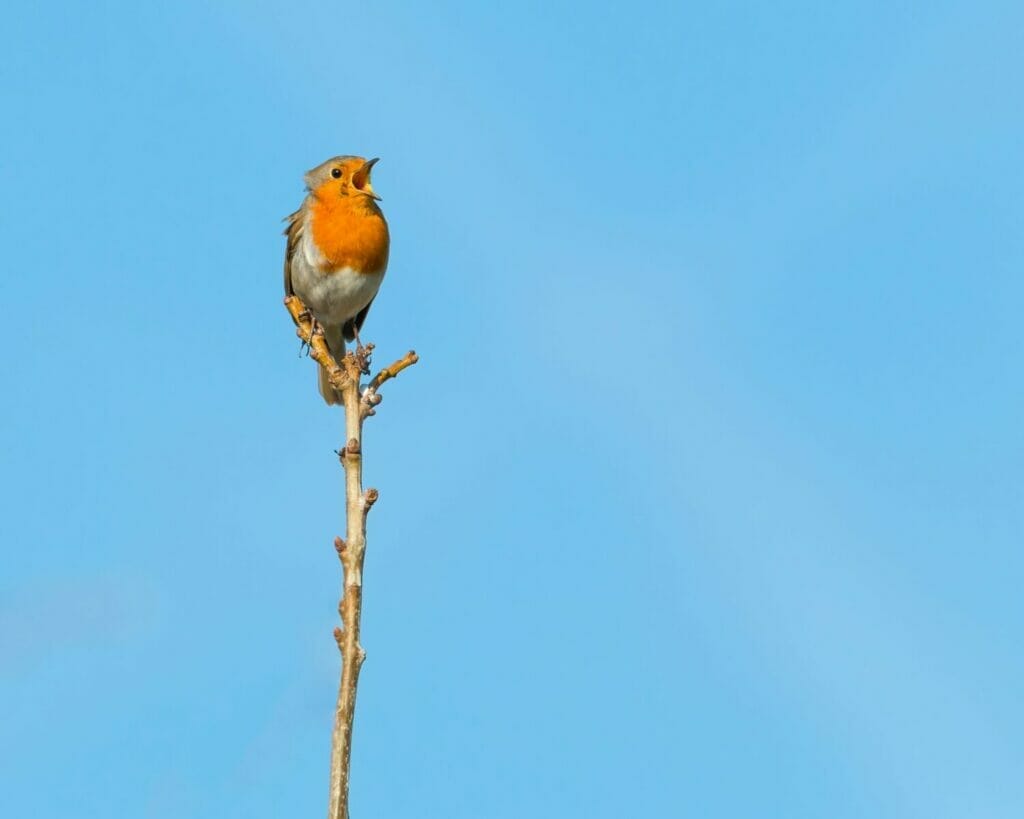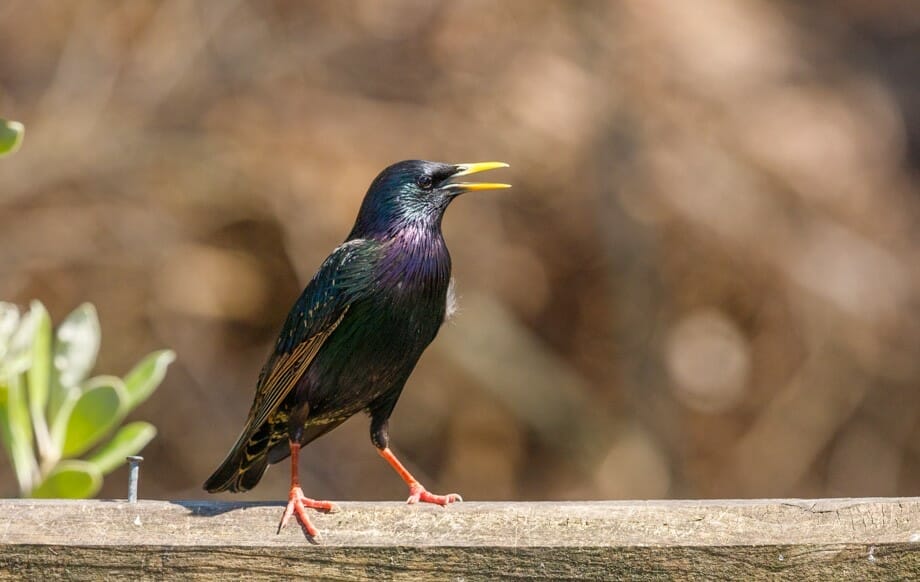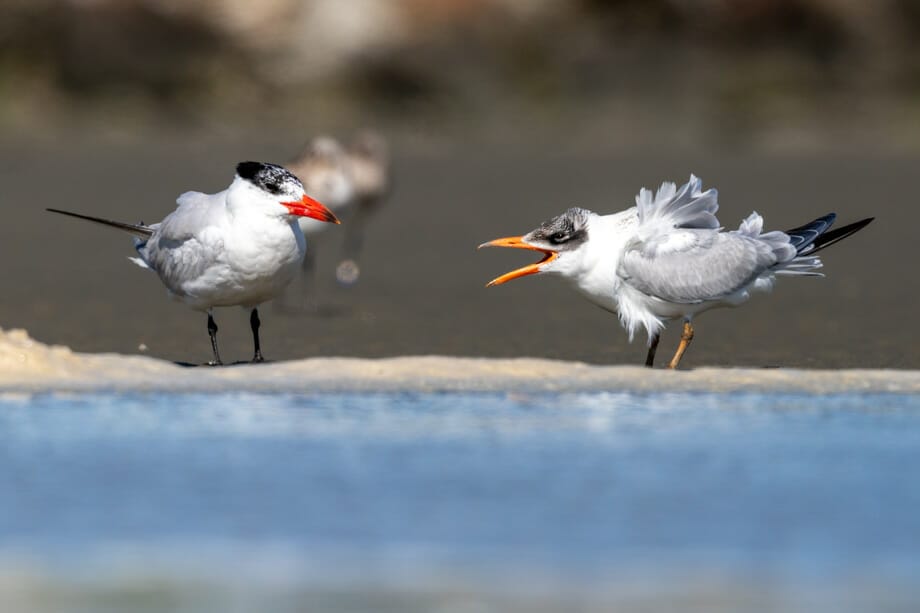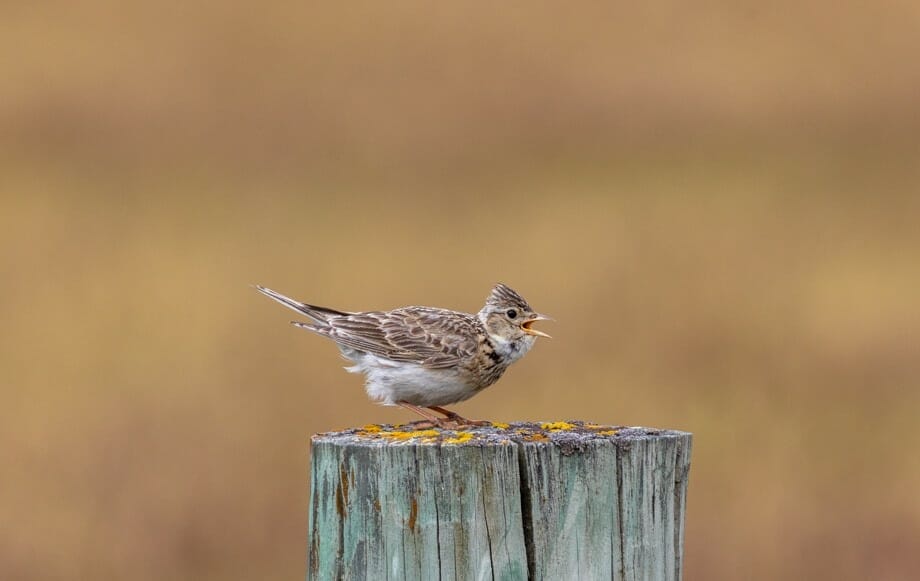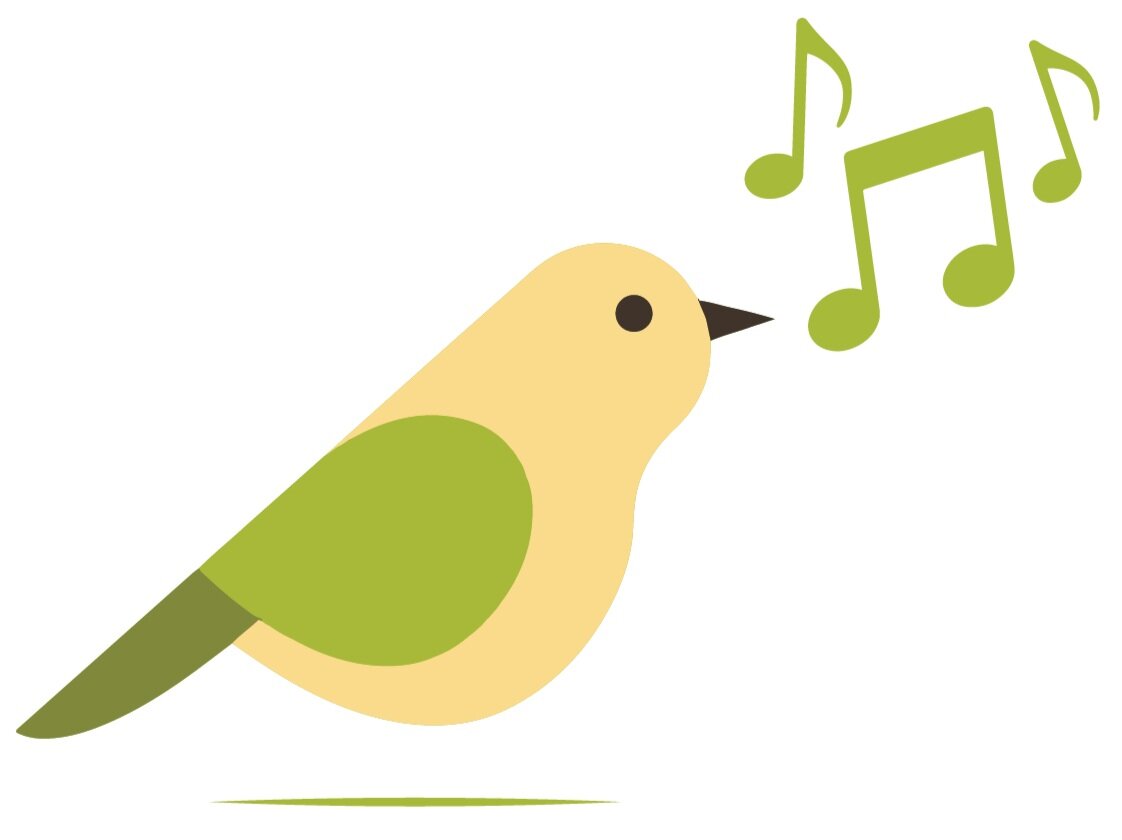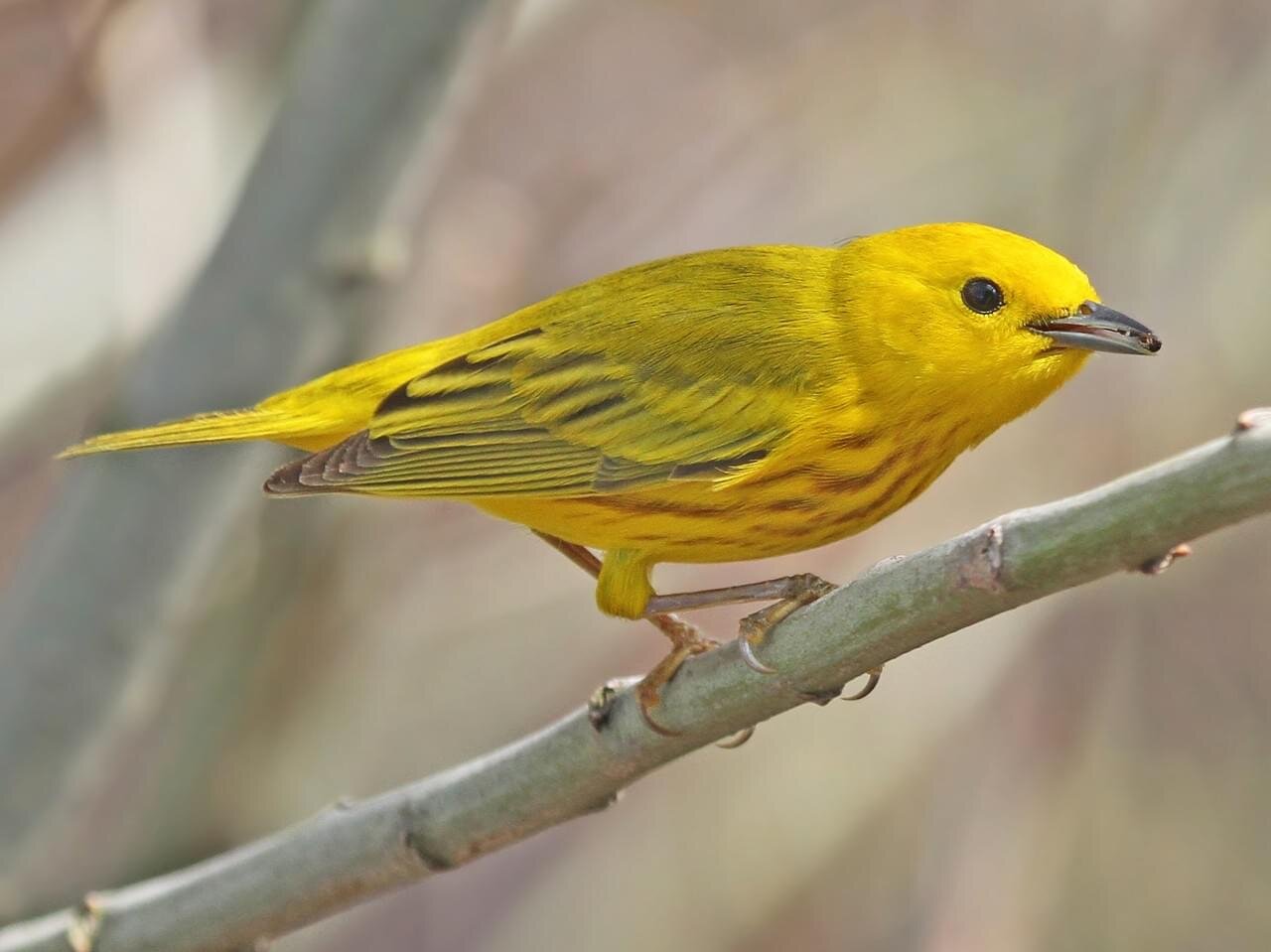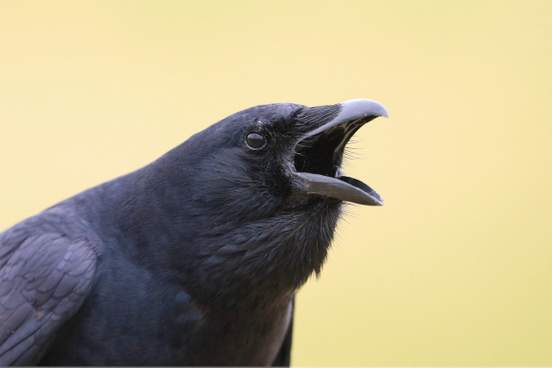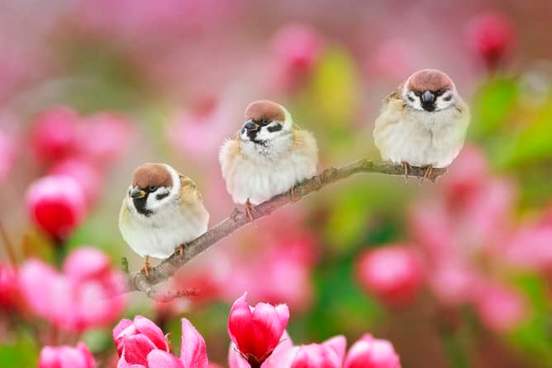If you live near the woods or have a backyard that birds often visit, you probably hear a mixture of bird sounds. These sounds might sometimes seem like melodic tunes, tiny tweets, or outright piercing calls. But what are the names of sounds of birds?
If you’ve ever wondered about the names of sounds of birds and what they possibly mean, we’d be glad to help. Let’s give you some insight into the fascinating world of birds!
Birds make a wide array of sounds, and each one has its own purpose. But before we try to interpret them, you should probably know the name of each sound that a bird makes first.
Sing
Birds sing when they make a musical sound. Even though people tend to confuse a song for a call, these two sounds mean different things. In fact, if you listen closely enough, you’ll find that a bird song isn’t the same as a bird call.
Not to worry. We’ll tell you the differences between the two sounds later on.
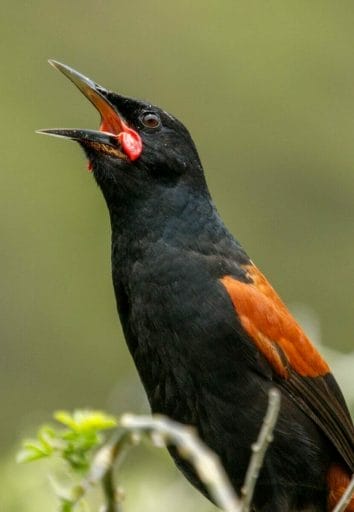
Tweet/Chirp/Twitter
We use the words twitter, chirp, or tweet when a bird makes short, but rather high sounds. If you’re a morning person, you may be familiar with the tweets of early birds.
Shriek/Cry
A bird cries or shrieks when it lets out a loud, sharp sound. Oftentimes, bird cries are associated with calls of alarm and danger.
Hoot
A hoot is a sound produced by an owl. It’s deep and quite easy to identify.
Caw
A caw is the name of the sound made by a crow. Most people are familiar with the caw of a crow. Unlike the hoot of the owl, a caw isn’t deep.
Cock-A-Doodle-Do
This is the sound that a rooster makes, especially early in the morning. However, a lot of pet keepers argue that roosters tend to make this sound throughout the day as well. Just not as frequently as they do at dawn.
Cluck
A cluck is the short, low sound that chickens make.
Now that you know all the names of bird sounds, let’s dive a little deeper into our topic, shall we?
What Is the Difference Between Songs and Calls?
The difference between a song and a call may not always be easy to figure out. This is because birds have a wide range of songs and calls that differ from one species to another. But here’s what we can tell you about this matter.
Songs tend to be more complex than calls, not to mention that they often have a clear pattern. When it comes to songbirds and other types of birds including owls and nightjars, singing serves two purposes.
The first instance when a songbird sings is when it’s time to defend its territory. The other scenario is when trying to attract a mate. As you might have presumed, these two activities are done by males. So, when you hear a bird singing, it’s usually a he.
Bird songs are more popular during the breeding season.
On the other hand, calls are much more simple. They’re usually shorter than songs, and they only consist of one syllable. Unlike songs, calls are made by both sexes, and you can hear them all year round since they aren’t seasonal.
While most people assume that birdsongs are showy and melodic, that’s not the case with some bird species. For instance, Henslow’s Sparrow merely sings one syllable.
The fascinating thing about songbirds is that their basic call notes are born out of instinct. Yet, in some of these species, the young males must hear the song of their own species at a certain age to be able to learn it.
Later, as each one of those birds grows, every single one develops its own version of a song. This results in a huge variety of bird songs, which isn’t the case with calls.
What Are the Types of Bird Calls?
To the untrained ear, bird calls might sound all alike. Those who pay some more attention might notice changes in tempo or pitch from one call to another. But what’s really going on out there?
Contact Calls
When birds communicate with each other, they use contact calls. Typically, contact calls are necessary when looking for food.
A contact call tends to be short, fast, and quiet. It doesn’t carry or create an echo, which is important not to attract any predators. Although, birds sometimes make louder calls in case they’ve become separated from each other.
Flight Calls
Some bird species rely on flight calls when they fly in flocks. A flight call goes back and forth amongst the birds if they detect flocks of other birds passing overhead.
Author Note: When songbirds migrate, which usually happens during spring and fall, they produce flight calls, too. If you’re lucky enough, you might be able to hear their distinctive chirping at night during these seasons of the year.
Alarm Calls
A really cool thing about birds is that they can produce a wide range of calls designed to respond to different sorts of threats. It’s all based on the situation and the type of danger.
For instance, if a predator is flying overhead, a songbird will make a high-pitched, yet short sound. This way, the call will end immediately without drawing the raptor’s attention. At the same time, any other bird in the same area will hear the call and stay alert.
It’s also important to note that this type of alarm call is tailored not to reveal the exact location of its maker.
In other cases, birds might have to make louder alarm calls that will carry for a distance. In this scenario, a raptor will be perched on a branch nearby waiting to attack. So, a smaller bird will make a deep, loud call to rally other birds to scare the predator away.
As you can see, it’s quite incredible how significant and meaningful a bird call can be.
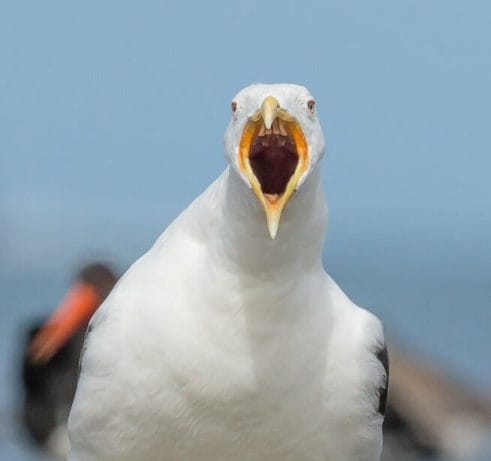
Begging Calls
Young birds make begging calls sometimes when they need their parents to feed them. Usually, these little calls are made repeatedly, and they’re often accompanied by a quick fluttering of wings.
If you ever come across such sounds, you may be tempted to get outside and watch these youngsters while they noisily ask for food. Just be careful to watch from a safe distance not to bother the birds.
Does A Sound of a Bird Vary According to Its Species?
Of course. Each species has its own unique songs, calls, and tweets. In fact, bird experts can tell the species of a bird by just listening to its song.
Yes, the call of a bird can slightly change depending on the situation. Still, each species has a naturally remarkable range of sounds that makes it different from other bird species.
How Do I Identify a Bird By the Sounds It Makes?
If you’re new to the world of birds, it can be tricky trying to identify a bird based on its looks, let alone its songs or calls. So, what if you want to know which birds visit your yard every day?
The good news is, you can totally do it without being an expert in birding. Fortunately, many helpful apps could give you a hand. All you’ll have to do is record the sound that the bird makes, then wait for the app to analyze it.
Eventually, you’ll end up with all the information you need about the species of this bird.
Our favorite bird-identifying apps are Birdgenie and BirdNET. So, you may want to try those the next time you go for a hike in the woods to add some more fun to your experience.
What Are Some Other Noises That Birds Make?
If you watch birds closely enough, you’ll realize that they make more sounds than the ones we’ve mentioned. However, these other noises are not vocalized.
Author Note: For instance, woodpeckers drum on the barks of trees to catch food in the form of bugs. Also, the mere movement of a bird can cause the leaves to shuffle. Plus, the flapping of a bird’s wings is another subtle sound that a bird creates.
While all these noises might be too minimal to help you identify a bird species, some could still be of huge help. For example, by measuring the pace of a woodpecker’s knocks, you might be able to gather more information about its exact species. Pretty cool, right?

Final Words
While the names of sounds of birds are pretty easy to learn, knowing the meaning behind a bird’s call might be tricky.
This is because these feathery creatures have undergone centuries of evolution. So, they’ve managed to come up with numerous calls to match each one of their needs.
However, you could still manage to identify the species of a bird based on the songs it sings. With the right bird ID app, it’ll only take you a few minutes. We hope you found this article on the names of sounds of birds useful.
Fly high friends!
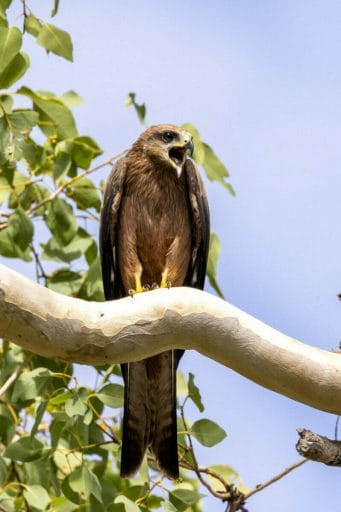
FAQ
Is there a free app to identify bird sounds?
Merlin Bird ID is a great app to identify bird calls.
What is the most common chirping bird in the United States?
Although it is not native to America, the humble House Sparrow chirps all day long. If the are present in your neighborhood, then likely you will be able to hear them.
What is the most gentle bird call?
It is widely recognized that doves have the most gentle calls. The cooing noise they make is so beautiful and calming.
Asked by: Granville Hammes
Score: 4.9/5
(24 votes)
synonyms for songbird
- canary.
- lark.
- oscine.
- pipit.
- serin.
- vireo.
- wren.
What is another name for a songbird?
In this page you can discover 13 synonyms, antonyms, idiomatic expressions, and related words for songbird, like: pipit, canary, oscine, serin, vireo, songster, skylark, mynah, corncrake, passerine and lark.
What does songbird mean in slang?
b : an oscine bird. 2 : a female singer.
What is a songbird in music?
A bird having a melodious song or call. 2. Any of various birds of the suborder Passeri (formerly Oscines) of passerine birds, having a syrinx with musculature that allows for the production and learning of complicated songs; an oscine. 3. A woman singer with a pleasing voice.
What is another word for birds singing?
In this page you can discover 8 synonyms, antonyms, idiomatic expressions, and related words for birdsong, like: birdcall, call, song, cicada, rustlings, bird-song, melodious and twitter.
28 related questions found
What is it called when birds make noise?
Sounds Birds Make
Begging Calls: Made by young birds, these plaintive calls are designed to draw attention and may include small peeps, whines, rasps, wheezes, and chirps.
What is the most common songbird?
House Sparrow
This bird, which is found throughout the U.S. year-round, is one of the most common songbirds in the world and lives in both cities and rural areas.
What is the most popular songbird?
Top Songbirds in America
- Bill Leman American robin.
- Courtesy Deborah Bifulco Baltimore oriole.
- Courtesy Garland Kitts Rose-breasted grosbeak.
- Bill Leman Summer tanager.
What is the largest songbird?
What is the largest songbird (member of the passerine family) in North America? Answer: At 22 to 27 inches long, the Common Raven is the largest songbird, though it can only croak.
Is Songbird a word?
a bird that sings. any passerine bird of the suborder Oscines. Slang.
Is Songbird a funeral song?
Mick Fleetwood: Fleetwood Mac – ‘Songbird’
“The song at my funeral, which will be in five minutes!
What is the meaning of Oscine?
: of or relating to a large suborder (Oscines) of passerine birds (such as larks, shrikes, finches, orioles, and crows) characterized by a vocal apparatus highly specialized for singing.
What is Canary means in English?
1 : a Canary Islands usually sweet wine similar to Madeira. 2 : a lively 16th century court dance. 3 : a small finch (Serinus canarius synonym S. canaria) of the Canary Islands that is usually greenish to yellow and is kept as a cage bird and singer.
What is the prettiest sounding bird?
Some people believe the thrushes, such as the Wood Thrush, or the Veery, have the most beautiful bird songs. Many people love the cry of the Common Loon.
Is it ethical to keep birds in cages?
Answer: Generally speaking, it’s not a good idea to keep lovebirds and budgies (parakeets) in the same cage. Lovebirds can be aggressive to other birds, and their beaks can cause serious damage.
Which is most beautiful bird in the world?
Here is a list of the most prettiest birds on the planet:
- Indian Peacock: The very mention of a beautiful bird produces images of an Indian Peacock in our mind! …
- Golden Pheasant: …
- Rainbow Lorikeet: …
- Keel-Billed Toucan: …
- Nicobar Pigeon: …
- Great Bird of Paradise: …
- Mandarin Duck: …
- Spatuletail:
Is a nightingale a songbird?
The nightingale is a small songbird of the Old World.
Nightingale can also refer to the closely related thrush nightingale, or the entire nightingale genus, or a few unrelated songbird species like the nightingale-thrush.
What are the top 10 most common birds?
The most common birds throughout the year in the United States are these:
- Mourning Dove (35% frequency)
- Northern Cardinal (34%)
- American Robin (33%)
- American Crow (32%)
- Blue Jay (28%)
- Song Sparrow (25%)
- Red-winged Blackbird (25%)
- European Starling (25%)
What is a lark a symbol of?
Larks are symbolic of joy, hope, and laughter. These birds start singing with the sunrise, scattering brightness and warmth in the world with their cheerful songs.
What is the first bird to sing in the morning?
Larger birds such as thrushes and doves are among the earliest singers because they are more active earlier in the day, while smaller species often join an hour or two later. Through the course of a morning, the composition of singers can change several times.
Why do birds chirp at 3am?
It’s a function of the breeding cycle. Birds declare and defend their territories with songs. Early to us is business as usual for them, especially the robins. They usually produce two clutches of eggs each year, so your friend might want to get some ear plugs if he doesn’t like the sound.
What is the most annoying bird call?
Mating call of the male koel bird is one of the most annoying sounds of spring.
Learn the Language of Birds
Lesson #1 — What Are Birds Saying?
Just like us, birds make many sounds and communicate many things through those sounds! Some of these sounds are easy to recognize. Take, for example, the flowery melodies of songbirds, or the call of a gull flying overheard, or the famous scream of a Red-tailed Hawk (often played in movies, but as the call of the Bald Eagle). Some are sounds you may have never heard before! And many are sounds you may not have known what they meant. In this lesson, you will learn more about the sounds bird make, the messages they are sharing, and practice skills that will help you to listen to birds.
What are birds saying?
Birds of all kinds have an incredible range in the types, pitches, volume, and tone of sounds they make. The songbirds are especially known for their vocal ability; these, for the most part, are the birds that sing. Birds that are not songbirds, like falcons, shorebirds, ducks, for example, may not sing but do have sounds that used for to say specific things.
SONGS
Songbirds, cuckoos, owls, nightjars…these are all types of birds that sing! Their songs are for marking territory and finding a mate. This is kind of like saying to competing birds, “This place is my home (stay away).” And to mates, “Come on over!” In most species, the males sing, but there are some in which females sing, too. Birds learn how to sing by hearing the songs of others in their species. They then, make their own unique version of a song!
CALLS
Calls may sound like a simple chirp, but calls can say lots of things! Birds use calls to check in with each other, let each other know there is danger nearby, and signal to each other when food is needed! Both male and female birds make these call notes. Birds are born knowing how to call.
Chickadees are well known for their calls. Let’s hear these calls and learn what they mean.
“Woohoo, where are you?” A single note can tell another bird of the same species where they are. This is heard in flight, especially when birds fly together to travel long distances, like in migration.
“Shhh…there’s a predator overhead!” Listen for the high-pitched, quiet call. This is used to warn other birds of a predator flying by. Birds will then wait, in hiding, for the danger to pass.
“Chase that predator away!” If the danger is imminent, birds at risk will make a loud call to action: get together and “mob” the predator. The birds work together to chase the predator away!
“I’m hungry, bring me food!” This is a begging call of a young chickadee looking for food from its parents. When outside in the mid- to late- spring, see if you can hear these calls!
Activity — Table Talk
Birds converse with each other throughout the day to say and share messages! In this activity, we will challenge you to communicate with another person using bird sounds. This is a chance to get a little silly, while learning the difference in nuances between different chirps, and songs. You can do this activity with one other person, or more, and with your family, friends, or room mates.
Instructions:
-
Together, make up a bird and decide what the following sounds from this bird will sound like. You can choose whatever sounds you would like to.
-
Song
-
Contact Call
-
Alert Call
-
Mob Call
-
Begging Call
-
-
Practice each sound until you feel comfortable proceeding to Step 3.
-
Attempt a conversation, using these calls! For families, this is a fun exercise to do while preparing a snack. For room mates and friends, try this out while doing a simple activity together, or on a video call.
Bonus Challenge — Try this activity again, but instead of making up a bird, decide on a bird you would like to study. Then, look up this bird on allaboutbirds.org. On the profile for your bird, select “Sounds” on the top right of the page.
Science Application — With a strong understanding of the sounds birds make, ornithologists, scientists that study birds, can pick out which birds are communicating and make educated guesses on what is being communicated. For example, if an ornithologist hears a chickadee gives its alarm call, they may begin searching the sky and tree tops for a falcon, hawk, owl, or another predator!
<<Back to top>>
Activity — Bird Song Meditation
Bird songs are a part of the melody of our daily lives. People across the continent recognize the sweet song of the American Robin as the announcement of spring; the croaking of crows and ravens are ubiquitous where people live; while the coo of doves can be heard through the still morning air in cities and countrysides alike. These sounds make up a part of the daily noise our ears and brain perceive each day.
This exercise will invite you to notice bird sounds as distinct from the daily sounds around you. This practice of noticing is a key step to starting your journey with demystifying bird language!
Instructions:
-
Find a comfortable position. Maybe you will be sitting, maybe you will lay down. Anything that works for you, works for this exercise.
-
Once you are ready, hit play on the audio recording below. This recording will take you through a 7-minute meditation.
-
This meditation is available in English and in Spanish. Select the language you feel most comfortable with.
-
-
Then, answer the questions below the recording. Entering your responses is entirely optional; the key is to work through the questions yourself. Whether you decide to share or not is up to you!
How many sounds did you notice?
Did any sounds surprise you?
Thank you!
Activity — Describe that Sound
As you’re starting off birding, it helps to pick a few birds to focus on, listen to their songs, and find your own words to describe what it sounds like. To do this, birders will also use mnemonics, a pattern of words that helps a bird song stick to memory! You will learn more about this in Lesson #3.
For now, you will:
-
Listen to each song or call. We selected birds that are readily found in Salt Lake City and are very distinct to each bird.
-
Then, find your own words to describe what the bird sounds like to you.
Here is an example:
“This bird sounds like a cricket playing laser tag! The cricket sound is that buzz I hear, and the laser sound are those high-pitched notes I hear.»
Fun Fact: The buzz is from the hummingbird’s wings! Birders call this buzz of a hummingbird it’s “trill.” Learn more about this bird here.
Now, you try! There are no right or wrong answers here. This is all about how you hear and interpret the sound. Write your responses on some scratch paper, or share your thoughts with us in the entry box for each bird.
What does this bird sound like to you?
Thank you!
What does this bird sound like to you?
Thank you!
What does this bird sound like to you?
Great job!
What does this bird sound like to you?
Thank you!
Bonus Challenge: One of the birds above is a female bird! You can tell because of a difference in the color of its feathers on its belly. Can you find out which one it is? Go to https://www.allaboutbirds.org and search for each bird. Go to the “ID Info” tab to compare male and female birds for each species.
<<Back to top>>
Lesson #2 — Seeing Bird Song
Introduction
Consider yourself a visual learner? Lucky for you, there is a way to learn bird language visually! Birders use a tool called spectrograms to see bird songs and calls. A spectrogram is like a graph of frequencies of a sound as it changes over time.
Spectrograms are useful for “seeing” bird song because it shows:
-
The tone of the sound (high or low pitch)
-
Pacing of the sound over time
-
How the sound changes
-
How loud the sound is! The brighter the line, the louder the sound, and vice versa.
Using spectrograms is a great tool, especially if you are a new birder, for helping your brain remember songs and calls! The visual association helps to reinforce knowledge to memory.
Activity — Get to know spectrograms
-
Watch the Bird Song Hero Tutorial video from the Cornell Lab of Ornithology (below).
-
Try to match the bird song to the spectrogram (below).
-
Scroll down for the answers.
This short introduction to Bird Song Hero trains you to interpret spectrograms, the sound visualizations scientists and musicians the world over use to help …
Activity — Match the song to spectrogram
Scroll down through each bird to listen to their song. Then, enter the spectrogram that you believe matches the song. Here are some hints:
1. Which spectrogram do you think belongs to the Mourning Dove?
2. Which spectrogram do you think belongs to the Eurasian Collared-Dove?
3. Which spectrogram do you think belongs to the Bullock’s Oriole?
4. Which spectrogram do you think belongs to the Yellow Warbler?
Birding Tip for Yellow Warbler in SLC: “I look for habitats next to water. In Salt Lake, you can find me in willow bushes and in trees along the Jordan River Parkway Trail and in the island of Liberty Park Pond! I hop about in the branches of trees, too. Look for a flash of yellow, moving quickly from branch to branch, and tends to stay in the middle height of the tree.”
Have you seen this bird? Tell us about when and where you see it on Facebook!
5. Which spectrogram do you think belongs to the Western Tanager?
Birding Tip for Western Tanager in SLC: “Each spring, I migrate into Salt Lake City from Mexico and Central America into the wooded canyons surrounding the city! A great spot to see me is from the parking lot for the City Creek Canyon Trail or from the trail itself. Take the trail, and then scan the canopy of the trees opposite of the trail for a flash of yellow and red! I stand out against the dense, green leaves of the trees.
Have you seen this bird? Tell us about when and where you see it on Facebook!
Answers: 1. Spectrogram A; 2. Spectrogram B; 3. Spectrogram C; 4. Spectrogram C; 5. Spectrogram A
<<Back to top>>
Application — Spectrograms at Work in the Bird World
How do spectrograms work in the real bird world? Join Feminist Bird Club (FBC) in this virtual birding experience!
Check out this video on how spectrograms work and how birders use them to figure out…who the heck is singing?! This video is posted with permission from the FBC-San Francisco Bay Area Chapter.
About Feminist Bird Club: Feminist Bird Club is a bird watching club 🦆 for LGBTQ+ folks, women, and BIPOC with chapters in New York, Boston, Chicago, SBA, Toronto, Seattle, Madison, San Francisco, and the Netherlands. Sister clubs are found in Buenos Aires, Mexico City, and Mérida. Follow for online events, stories, and tips. IG: @feministbirdclub
Extension Activity — East Coast vs West Coast Birds
Can’t get enough of spectrograms? Keep quizzing yourself with the Cornell Lab of Ornithology’s Bird Song Hero Spectrogram Quiz. Please note, because Cornell is in Ithaca, NY, this video features birds found east of the Rockies.
Bonus challenge: Many of the eastern birds are similar to species in the western United States. Take the Bird Song Hero Spectrogram quiz, then use the links below to see similar species, found in Salt Lake, and compare their songs.
Extension Activity — DIY (Draw it yourself)
Try visualizing bird song on your own by listening to a song, and then drawing what you think the spectrogram would look like.
Instructions: For this activity, you will need a pencil and a piece of paper.
-
Draw a line down the middle of the page. Then, in rows, draw rectangular boxes on each side of the page. These will be your spectrograms for each bird.
-
Label the column on left “My Spectrogram” and the column on the right “The Bird’s Spectrogram.”
-
Label each row by the bird (listed below). Your page should look like this:
-
Listen to each track, and draw in the rectangles in the left column labeled “My Spectrogram.” This will be what you think the spectrogram would look like. Count the notes, and makes the lines thicker where you think the bird is singing loudest.
-
Then, click the link “This Bird’s Spectrogram” to see what their spectrogram actually looks like. Draw this image into the rectangles on the right labeled “The Bird’s Spectrogram.”
-
Compare and contrast: How did you do? Take notes in each row!
Lesson #3 — Bird mnemonics
Mnemon-what?! Everybody loves a gimmick! So why not try one when learning bird songs? Birders use catch-phrases to memorize the rhythm, quality, pitch and tempo of bird songs. These patterns of words or phrases are called mnemonics!
Mnemonics are cultural! The cool thing about mnemonics is that there are phrases unique to each language! The mnemonics selected here are largely in English. Birders in different countries use different catch phrases to help memorize the sounds of their local birds. The mnemonic for the same bird can also vary from region to region, even within the same country!
In this lesson, you will: Learn a few common mnemonics in the United States for birds heard in the Salt Lake area, while trying to create some mnemonics of your own. Then, you will be encouraged to look for bird by using mnemonics!
Activity — Get to know mnemonics
-
Listen to each recording of a bird song (below) and mouth the mnemonic out loud as the bird is singing. See if you can match the words of the mnemonic with with the notes in the bird’s song.
-
Count the syllables in the bird’s song. Enter that answer.
-
Teaching Tip for Kids (9 or under): Teach your children about syllables by having them clap to each one! Use a word they are familiar with first, like “giraffe” or their own name. Here’s a lesson to use. Then, work up to trying out the words in the mnemonics below.
-
-
Make your own mnemonic, and repeat step 1!
-
By entering your mnemonic, you are giving Tracy Aviary permission to share your entry on our social media accounts. We do not ask you for, nor will we post, personally identifiable information in these forms.
-
Black-capped Chickadee
Carbonero Cabecinegro
Listen to more sounds of the Black-Capped Chickadee here.
Mnemonic birders use: Hot dog! Cheeseburger!
Tips: Chickadees have parts to their song. See if you can hear these two pieces in the recording. Below, consider: how many syllables are in “hot dog?” How many syllables are in “cheeseburger?”
Try your own mnemonic!
Pick words that match the syllable counts you listed above. They can be words of objects, people, sounds, or anything you would like! Choose any language you would like, as well. The goal is to pick something that makes sense to you! Here is an example for the chickadee, using the word for cookie in Spanish (galleta):
Example mnemonic: Cookie! Galleta!
Yellow Warbler
Reinita de manglar
Listen to more sounds from the Yellow Warbler here.
Mnemonic birders use: Sweet, sweet, I’m so sweet!
Tips: Yellow warblers sing loud and proud throughout the whole spring! Once you pin this song down, you won’t miss it. Below, consider: how many syllables are in this complete phrase?
Killdeer
Chorlitejo Culirrojo
Listen to more sounds from the Killdeer here.
Mnemonic birders use: Killdeer!
Tips: While this bird does not sing, it does something really useful: it calls out its own name! Below, consider: how many syllables are in this bird’s call?
Spotted Towhee
Toquí Moteado
Listen to more sounds of the Spotted Towhee here.
Mnemonic birders use: Drink your tea!
Fun fact: This mnemonic translates into Spanish directly as, “Toma té!”
Tips: Below, consider: how many syllables are in this bird’s song? Bonus challenge: Listen to the song of its eastern cousin, the Eastern Towhee, and compare what you hear.
More Mnemonics: Did you enjoy this activity? Use these resources to learn more mnemonics of common birds in the United States!
Mnemonic Cartoons Western Birds Eastern Birds
Activity — Mnemonics Listen and Share
Put your mnemonic practice to work by applying the gimmick to pick out the bird in the wild! In this exercise, “wild” is loosely applied to anywhere you can hear birds sing and call. This exercise can be done by sitting at a window, patio, or yard; in your neighborhood; by visiting a park; hanging out alongside a stream; on a trail; at the pool; or anywhere with access to sounds outside that is comfortable to you.
Instructions:
-
Focus on 1-3 common birds in your area. You may select the birds highlighted in the “Get to Know Mnemonics” exercise above, or select birds from a local bird list.
-
Common Birds:
-
Common Backyard Birds of Salt Lake
-
Common Backyard Birds — East Coast & Midwest
-
-
Teaching Tip for Kids (9 or under): Work with one bird at a time. Start with a bird you and your child are most interested in, go through steps 1-5, then repeat with another bird.
-
-
Use the steps in the “Get to Know Mnemonics” exercise to study the mnemonic for the bird[s] you chose.
-
Tip: You may use the standard mnemonic, or come up with your own!
-
Teaching Tip for Kids (9 or under): Clap the syllables with your child. Sing the melody of the song while counting the syllables. Then, do a sing-along of the mnemonic with the melody, while clapping the syllables.
-
-
Choose a space that is most comfortable for you to listen for bird songs and calls. This can be a window or a location outside.
-
Listen!
-
Tip: Have patience. It may take a little bit to a) pick the sounds of bird songs and calls apart from the noise of your surroundings and b) to hear the bird you are listening for!
-
-
Once you hear something that reminds you of your mnemonic, start to sing along using your catch phrase or gimmick.
-
If 15-20 minutes go by, and you are not hearing the bird you chose, repeat steps 1-5 with another common bird. Also, read through the next activity, “Mnemonic Data” to learn a frustrating, but golden rule in birding when it comes to science: no data is still good data.
-
<<Back to top>>
Extension — mnemonic data
“No data is still good data.”
Don’t get discouraged if you don’t hear your bird mnemonic! A part of the joy of birding is the frustration of not finding what you’re looking for. When you do, it just makes the discovery that much sweeter! It also can tell you that the bird you are looking for doesn’t live in the place you are listening in.
Scientists will revisit the same place over and over again to listen and look for birds. When they do this, they take notes on what they hear and see. By noting what they find, they can start to see patterns of where certain birds are, and certain birds are not.
You, too, can do science! Be a backyard scientist by applying your mnemonics to write what you notice. This is an introductory exercise to one way ornithologists study birds.
-
Choose a space that is most comfortable for you to listen for bird songs and calls. This can be a window or a location outside.
-
Find a place where you can take notes. This can be your cell phone, a journal, or a notepad.
-
Visit the space on different days. Take your cell phone, journal, or notepad with you. Take notes on:
-
The date and time you begin listening
-
The birds you are listening for. Use the mnemonics you are studying and focus on those birds. Then, tally how many times you hear (and see) each one!
-
-
Once you have three visits done, start to see if you can find any patterns! Here are some questions to start asking yourself:
-
Are there any birds that I hear a lot of in this space?
-
Do I notice if I tend to hear or see them in a certain part of the space?
-
Are there any birds that I do not hear or see in this space?
-
Why are the birds there, or why are they not there?
-
The Teaches of Screeches
Photo: Drew Chaney — Cornell Lab of Ornithology
With the spring migration of hundreds of bird species underway throughout North America, you may hear an unfamiliar call, song, or other bird-related noise in the coming months, whether you live in the city or country. With thanks to the Cornell Lab of Ornithology’s Macaulay Library for the audio and visuals, here’s a list of fifteen common and not-so-common words for avian utterances that might help you distinguish a veery from a vireo.
Like many words for bird calls—including several on this list—hoot is imitative in origin. An “imitative” or “onomatopoeic” word (e.g. buzz) tries to capture the sound it describes. So when you say it out loud, hoot sounds like the natural throat noise produced by some owls. Try it! As we’ll see further down, not all owls hoot, but barred owls and great horned owls do.
Barred Owl:
Great-Horned Owl:
One sense of laugh is “to show emotion (such as mirth, joy, or scorn) with a chuckle or explosive vocal sound.” Since ascribing emotion to such birds as the common loon and laughing gull would be anthropomorphism, another sense in our dictionary—”to produce the sound or appearance of laughter”—is a better fit.
Common Loon:
Laughing Gull:
A screech is a “high shrill piercing cry.” One of the most famous bird screeches is that of the red-tailed hawk, which you might recognize from movies and television shows that dub it over the less strident call of the bald eagle to make that national symbol sound tougher. Another screecher is the barn owl, whose raggedy wail might raise the hair on the back of your neck.
Red-Tailed Hawk:
Barn Owl:
Croaking’s not just for frogs! Yet another imitative word, croak is defined as a “hoarse harsh cry or sound,” which describes the calls of both the common raven and the American bittern.
Common Raven:
American Bittern:
The definition of caw is similar to croak—both are “harsh”—but caw gets the added descriptor “raucous.” This makes perfect sense for the gregarious birds most associated with cawing: crows. Compare the differences in the caws of two crow species, the American crow and the fish crow…
American Crow:
Fish Crow:
Not all bird sounds are vocalizations. The male ruffed grouse, for example, drums (throbs or sounds rhythmically) by rapidly rotating his wings back and forth (up to five times a second), producing a deep, low thumping you can almost feel as much as hear.
Ruffed Grouse:
A chirp is the “characteristic short sharp sound especially of a small bird” and perhaps one of the quintessential bird sound words in English. American goldfinches emit a series of chirps that some say sounds like “potato chip,” while the red-eyed vireo perches high in the treetops where it can chirp for hours on a long summer day.
American Goldfinch:
Red-Eyed Vireo:
A trill can mean “the alternation of two musical tones a diatonic second apart” or “a sound resembling a musical trill.” The flute-like trill of the wood thrush is perhaps the most beautiful song of any North American bird. The descending trill of its relative the veery isn’t too shabby, either.
Wood Thrush:
Veery:
To warble is “to sing in a trilling manner or with many turns and variations.” An entire family (Parulidae) of North American birds is known as the New World Warblers for the quality of (many of) their songs and calls. The song of the Louisiana water thrush—a warbler, not a thrush!—is a mirthful warble heard often beside quick-moving streams in early spring.
Louisiana Waterthrush:
Ruby-throated and black-chinned hummingbirds can produce a buzz, “a persistent vibratory sound,” with their wings. Other birds, like the black-throated green warbler and the northern parula, sing with a distinctly buzzy quality.
Ruby-Throated Hummingbird:
Black-Chinned Hummingbird:
Black-Throated Green Warbler:
Northern Parula:
A whinny is “the neigh of a horse” (of course of course), but also any sound resembling a whinny. Despite its name, the eastern screech-owl doesn’t screech, it whinnies, as does the pileated woodpecker.
Eastern Screech-Owl:
Pileated Woodpecker:
A whistle is “the shrill clear note of a bird or other animal,” and lots of birds whistle—from the soaring broad-winged hawk to the tiny, tree-climbing brown creeper.
Broad-Winged Hawk:
Brown Creeper:
Spoiler alert! The definition of coo, “to make the low soft cry of a dove or pigeon or a similar sound,” would seem to tell the whole story. But other birds coo as well; the greater sage-grouse for example, emits a series of cooing notes as part of a display that also includes swishing (of wings), booming (from its yellow air sacs), and whistling.
Mourning Dove:
Greater Sage-Grouse:
Peent is not entered in our dictionary, due to its rarity, but it’s a word often used by birders to describe the curt, nasal call made by both the American woodcock (low to the ground near the edges of fields and wetlands) and common nighthawk (high in the sky over cities, fields, and woodlands).
American Woodcock:
Common Nighthawk:
Before a tweet was “a post made on the Twitter online message service,” it was “a chirping note.” So, think again of a “short sharp sound” resembling the sound of the word itself. To our ears the lazuli bunting, a vibrantly hued songbird of western North America, absolutely tweets, as does the northern cardinal. If these and the other bird sounds in this gallery delighted you, tweet about it (both senses)!
Lazuli Bunting:
Northern Cardinal:
Bird Words
‘Auspicious’, ‘musket’, and ‘volatile’ all have origins related to birds.
SEE THE LIST >
The idea for the Describing Words engine came when I was building the engine for Related Words (it’s like a thesaurus, but gives you a much broader set of related words, rather than just synonyms). While playing around with word vectors and the «HasProperty» API of conceptnet, I had a bit of fun trying to get the adjectives which commonly describe a word. Eventually I realised that there’s a much better way of doing this: parse books!
Project Gutenberg was the initial corpus, but the parser got greedier and greedier and I ended up feeding it somewhere around 100 gigabytes of text files — mostly fiction, including many contemporary works. The parser simply looks through each book and pulls out the various descriptions of nouns.
Hopefully it’s more than just a novelty and some people will actually find it useful for their writing and brainstorming, but one neat little thing to try is to compare two nouns which are similar, but different in some significant way — for example, gender is interesting: «woman» versus «man» and «boy» versus «girl». On an inital quick analysis it seems that authors of fiction are at least 4x more likely to describe women (as opposed to men) with beauty-related terms (regarding their weight, features and general attractiveness). In fact, «beautiful» is possibly the most widely used adjective for women in all of the world’s literature, which is quite in line with the general unidimensional representation of women in many other media forms. If anyone wants to do further research into this, let me know and I can give you a lot more data (for example, there are about 25000 different entries for «woman» — too many to show here).
The blueness of the results represents their relative frequency. You can hover over an item for a second and the frequency score should pop up. The «uniqueness» sorting is default, and thanks to my Complicated Algorithm™, it orders them by the adjectives’ uniqueness to that particular noun relative to other nouns (it’s actually pretty simple). As you’d expect, you can click the «Sort By Usage Frequency» button to adjectives by their usage frequency for that noun.
Special thanks to the contributors of the open-source mongodb which was used in this project.
Please note that Describing Words uses third party scripts (such as Google Analytics and advertisements) which use cookies. To learn more, see the privacy policy.

